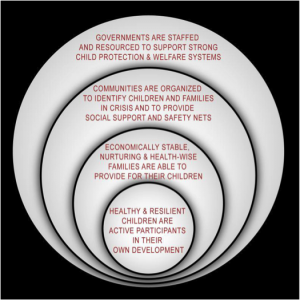“Investing in social protection and children makes sense from both an economic and a human development perspective. The demonstrated impacts of social protection on children’s development last long beyond childhood, increasing adult productivity, decreasing the burden of human development losses, and contributing to breaking the inter-generational cycle of poverty.” (UNICEF, 2012)
Protecting orphans and vulnerable children (OVC) from the multiple and diverse impacts of HIV and AIDS is a responsibility that is shared among families, communities, civil society and governments. The social ecological model helps us to examine the levels and types of relationships and interactions among the actors and systems that affect the development of a child, and can be a useful conceptual framework from which to design programming in support of children affected by HIV and AIDS. The basic premise of this model is that the environment and the interactions a child has with key people in their environment greatly affect a child’s development. (1) Furthermore, connections and interactions among environments at different levels of the model (e.g., families and schools or churches) also influence a child’s development. (2)
At every level of the social ecological model, families, communities, government and civil society play a unique and essential role in supporting child development and in shaping the total social protection system. The strength of the social protection system depends upon: 1) effective interactions among the levels in the social ecological model and 2) successful collaboration with other systems such as health, education and justice. (3)
The diagram below is an adaptation of the social ecological model for orphans and vulnerable children programming and shows the importance of each level in creating a cohesive response for children affected by HIV and AIDS.

Diagram: Supporting children and families affected by HIV and AIDS. (4)
Going forward, the discussion focuses on the adapted model for Supporting Children and Families Affected by HIV and AIDS. Children are at the center of the model, and programs need to consider a [child’s] environment at all levels from the household and community to service delivery providers and policy frameworks [to identify opportunities to support child well-being and to positively influence] behavioral changes in family and community social norms. (5)
Orphans and vulnerable children’s programs should also strengthen the social protection systems at every level: Child and Family, Community, Civil Society and Government (Ministry of Social Welfare or other Ministry responsible for OVC Services), and help build connections between levels of protection networks and other systems.